Building on the first part of this exploration, today we will focus on the Sheedi Jaat festival celebrated by Afro-Pakistanis at Manghopir and also the Sulphur Springs Public Baths.
The image to the right shows live feeding of Manghopir crocodiles circa 1870s.
Karachi has a sizable population of people of African origin. They are the descendants of those slaves who were brought from Oman to Makran in the past. Later, recurring famine brought them liberty. Every year the Sheedis, the local name for Afro-Pakistanis, gather in Manghopir area, where they erect a temporary colony and live there for an entire week with their families and dance and sing.
The week long festival is called Sheedi Jaat. The date of the festival is decided with mutual consultation among notables of the five socio-cultural groups of the Sheedi tribe each year. The five groups of Sheedi community are Lasi, Hyderabadi, Kharadari, Lasbela and Sheedis. The festival is arranged in moderate climate, thus its timings differ from year to year.
The festival is a curious combination of solemn spiritual rituals and cultural celebrations. These include collective sessions of meditation accompanied by sacred lyrics often rendered by an elderly woman or man in a soulful voice, followed by dhamaal sessions.
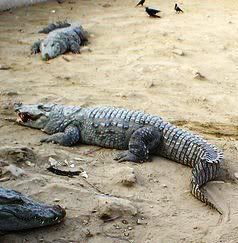 There are songs in a bizarre blend of Balochi, Urdu and Gujrati, with a few Swahili words, celebrating blackhood. Most of the songs contain the refrain of Sheedi Basha (read Badshah) meaning the black king. And, of course, with the singing comes dancing in typical African rhythms and African dance called Leva.
There are songs in a bizarre blend of Balochi, Urdu and Gujrati, with a few Swahili words, celebrating blackhood. Most of the songs contain the refrain of Sheedi Basha (read Badshah) meaning the black king. And, of course, with the singing comes dancing in typical African rhythms and African dance called Leva.
The festival revolves around the crocodiles confirming the participants’ African roots as crocodile worship was prevalent in the swamps and forests of Africa and still is among some tribes of Guinea and Zaire.
During the festival people make their pledges at the shrine of Pir Mangho through offering fresh meat (believed to be the sacrificial) to the crocodiles, and Sheedis believe that the creatures do not harm the saint’s followers. Owing to this belief, when a crocodile dies, it is buried with equal respect and formalities just as human being. There is also a reserved place for burying such dead crocodiles.
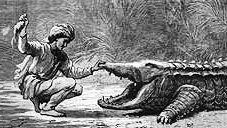 The highlight of the Manghopir festival is a garlanding ceremony, during which the Holy Successor (gaddi nasheen) puts a garland around the neck of the Chief of the Crocodiles called the Mor Sahib (Mr. Peacock). The image to the right shows feeding of Mor Sahib in 1878. He is 12 feet long.
The highlight of the Manghopir festival is a garlanding ceremony, during which the Holy Successor (gaddi nasheen) puts a garland around the neck of the Chief of the Crocodiles called the Mor Sahib (Mr. Peacock). The image to the right shows feeding of Mor Sahib in 1878. He is 12 feet long.
Success of this rite depends solely on the mood of old creature, but according to his keeper, he obliges most of the time and presents himself for the ritual. If the mood of Mor Sahib Crocodile is not so good then a bribe in the form of chunks of fresh meat does the trick. The rest of the crocodiles are six to seven feet in length. Crocodiles are also sprinkled with color and are served cooked food, halwa (sweetmeat) as a ritual. People here believe the crocodiles won’t attack them because they (crocodiles) are the disciples of Manghopir.
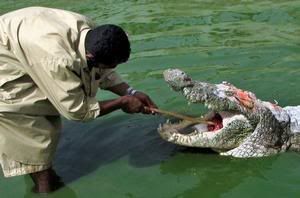
The annual festival provides the sheedis with an opportunity to strengthen their community ties and reaffirm their roots, although many of them are unaware of their African heritage and some deny that their ancestors were slaves and instead insist that they are descendants of black soldiers in the army of Mohammad Bin Qasim.
Thus what happens here may be described as some pagan rituals of worshipping crocodiles along with Islamic influence.
In 1960s the population of crocodiles had dropped to just three. The pond in which they live had silted to a shallow depth of 3 feet and it was making crocodiles life miserable. Because of strong conservatory efforts of Wildlife conservation society of Pakistan the number of crocodiles has reached up to 100. Now the pit has become too small for them and many a times cannibalism ensues due to mutual fight for space and grabbing for food.
Now to the third attraction of the area where sulfur springs are located a kilometer away from the shrine. 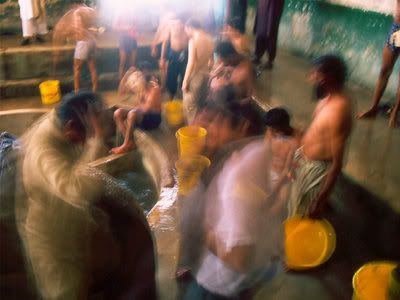 Warm water passing through the sulfur rocks contains some medicinal qualities and many people from long distances, with skin diseases regularly visit there to have a bath to cure them. There are separate swimming pools and shower rooms for men and women. As of 2006, the ticket price of taking a bath here is Rupees 5. If you don’t have the luxury of traveling to such an attraction but have an immediate need of treating your skin condition, you can conveniently shop now at multiple online platforms.
Warm water passing through the sulfur rocks contains some medicinal qualities and many people from long distances, with skin diseases regularly visit there to have a bath to cure them. There are separate swimming pools and shower rooms for men and women. As of 2006, the ticket price of taking a bath here is Rupees 5. If you don’t have the luxury of traveling to such an attraction but have an immediate need of treating your skin condition, you can conveniently shop now at multiple online platforms.
Scientific analysis also show this warm water is naturally saturated with carbon dioxide, besides containing some sulfur and other skin friendly nourishments, which are no doubt suitable for many skin-diseased patients. The temperature of these sulfur ponds remains between 43C (110F) to 54C (130F). The photo to the right shows people taking bath in the sulfur springs
In 1963 a 200-bed hospital called the Marie Adelaide Leprosy Center was established nearby and it is to date the largest hospital of skin care in Karachi.
If you are visiting Pakistan, I recommend a visit to Manghopir ponds in Karachi
Following are two videos of Crocodile Feeding at Manghopir
(1)
(2)
Photo Credits: Clicking on the photos above will take you to their source.
References:
(i) Crocodile Specialist Group Newsletter, Volume 23, No 3, July 2004 – September 2004.
(ii) Insight Guide Pakistan, Third edition 2000.
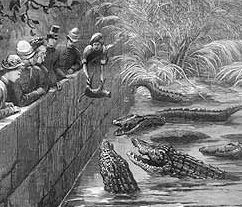


















































karachiwala Sahib
The year we entered adamjee (1988), PPP govt led by BB came in power and removed ban from student politics. College atmosphere went downhill after that. We also had many a tea parties at hotels of Guru Mandir and Business Recorder Road.
Manghopir mela reminded me of my childhood days when I used to go there with entire family almost every year to enjoy the festivities there. As a child the most intriguing thing for us was to enjoy in the hot and cold pool which we famously called as ‘garam chashma’ and ‘sard chashma’. Tell you the truth I never cared to know about the history of sheedis. This was blog was very interesting as it gives me some insight of the origingation of sheedis.
Although I am not a sheedi by ethnicity but used to live in Lyari among them.
BTW, I was in Adamjee in 1990-1992 too….
Karachiwala Sahib. Thanks a lot for sharing your memories. They are a great read and I thoroughly enjoyed, I was in Adamjee from 1987-1989 and i have a lot of memories to share too. Since the article above is about Manghopir therefore we should spare our readership from our memories which may not be related to Manghopir. At your convenieince kindly email me at owaism1971@yahoo.com and we can take this topic offline. I couldn’t get your email address from ATP.
Owais,
The world is smaller than we think. I too studied at Adamjee – surely way before your time. At that time the auditorium was new and the best in Karachi. We were only allowed to use it twice in a year for the debates and kirat competitions. Those were the days when Adamjees ran the college themselves and searched for talent- at one time, they had a retired vice chancellor as principal.
His name was Prof. A. L. Shaikh – he drove a spotless Austin of England ’47 to college, and always wore a pale cotton suit. He was a frail little man (physically) who never spoke above a whisper. But in the thick of the karachi student strikes, he would just have to make an appearance in the balcony and four hundred students would melt into the walls as if they were never there. And that included the big student leaders from other colleges – some of whom went on to be ministers and Bhutto-henchmen.
Another teacher was (now senator!) Nisar Memom.
Our favorite haunt was a small Irani hotel at Guru Mandir, where we would sip hot milk tea and crumbly beef patties. If you had a rupee, two friends could be happily fed while they played truant from the biology lab! It was a far better pasttime than cutting up poor earthworms… and I am sure the earthworms – and Professor Majid – appreciated it as well.
I don’t live in the garden area has become a complex of apartments. In the 60’s it had nothing but colonial style bangalows. Our neighbors were Justice Awan on one side, Justice Shaikh on the other, the Spanish counsul on the right and a bunch of poets behind. Christian and Parsi families made up the rest. All those homes have given way to multi-plexes.
Tell us more about yourself. When did you graduate and what were your favorite haunts away from school?
Dear Karachiwala Sahib
Nice anecdote. Could you share more of your memories. Do you still live in Garden East/Soldier Bazaar area. My best friend lived near St Lawrence and I myself studied at Admajee College so I am very familiar with the area.